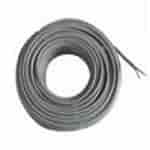Shielded Cable
There are many environments in which you’ll find multiconductor cables, and some of them come with high electromagnetic interference (EMI). EMI can cause several undesirable effects, and the addition of shielding can help a cable better withstand it. This makes it a popular choice in many demanding data environments. WesBell Electronics offers a wide selection of shielded multiconductor cables all built with quality at the forefront of design.
Working With WesBell Electronics
Here at WesBell Electronics, we’ve been finding ways to meet our customers’ unique needs since 1988. Not sure if shielded cabling is appropriate for your project? Just run us through it, and our expert staff will be happy to help. If shielded cable isn’t the right pick, we also offer an array of other multiconductor cables as well as hook-up wire and portable cord.
We also offer a wide range of wire processing services to help you save time and find quality results. Click on the links above to explore our shielded multiconductor cable options or reach out to us to learn more!

